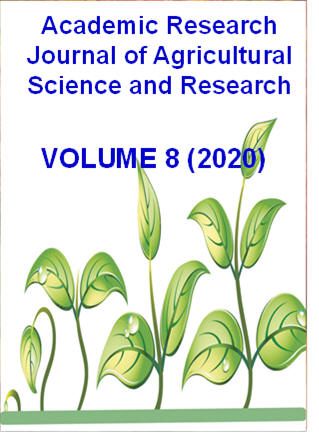|
ISSN: 2360-7874 |
Academic Research Journal of
Agricultural Science and Research |
|||||||||||||||||||
|
Vol. 8(4), pp. 325-338, May 2020 Research Determination of Fungicide Spray Frequency for the Management of Septoria Tritici Blotch (Septoria tritici) of Bread Wheat (Triticum aestivum L.) in the Central Highlands of Ethiopia
Yitagesu Tadesse*1, Belachew Bekele1, Asela Kesho1
1. Department of Plant Pathology, Holleta Agricultural Research Centre, Ethiopian Institute of Agricultural Research , P.O. Box 2003, Addis Ababa, Ethiopia * Corresponding author: Yitagesu Tadesse; Email: tyitagesu4@gmail.com
Accepted 28 May 2020
Septoria tritici blotch (STB) is an economically important foliar disease in the major wheat-growing areas of Ethiopia. The current research was conducted to determine the impact of wheat varieties and fungicide spray frequency on disease development and wheat yield. The effect of bread wheat varieties and fungicides spray frequency on STB development, wheat yield was evaluated at Holleta in a factorial field experiment involving three bread wheat varieties and five fungicide spray frequency. Variety Kekeba had the highest AUDPC (4019) value followed by Madawalabu (3854) and Alidoro (2077) varieties. STB incidence and severity were significantly reduced by the application of fungicides across varieties but fungicide-variety combinations had differential effects on disease development. Wheat grain yield were the lowest from unsprayed plots regardless of variety. Alidoro variety treated with five times Tilt fungicide spray produced the highest yield (6.67t/ha). The highest (3013%) and lowest (0%) marginal rate of return were obtained from Madawalabu variety two time fungicide spray and from all unsprayed fields, respectively. The present findings confirmed the importance of STB in Ethiopia and the role fungicides frequency play in managing the disease on partially resistant varieties.
Key Words: AUDPC, Bread wheat, Cost-benefit analysis, STB, Spray Frequency, Tilt.
How to cite this article (APA Style): Yitagesu T., Belachew B., Asela K (2020). Determination of Fungicide Spray Frequency for the Management of Septoria Tritici Blotch (Septoria tritici) of Bread Wheat (Triticum aestivum L.) in the Central Highlands of Ethiopia. Acad. Res. J. Agri. Sci. Res. 8(4): 325-338
|
|||||||||||||||||||
